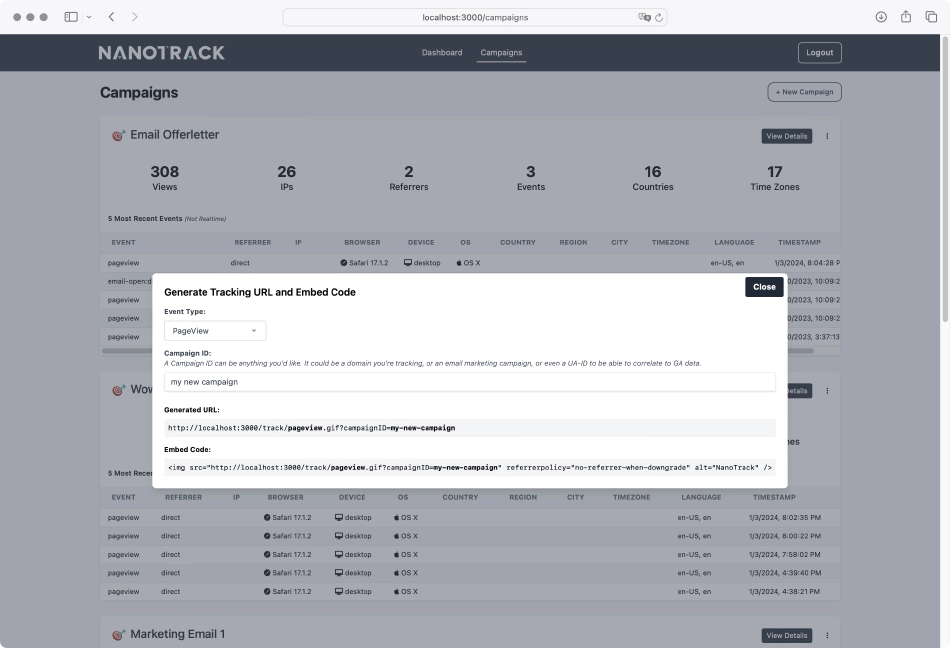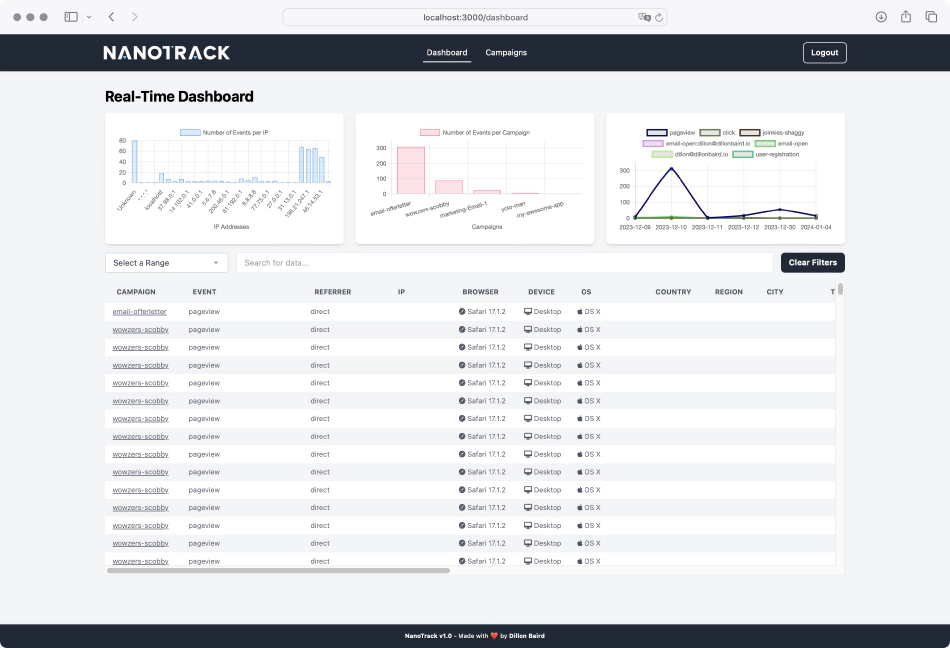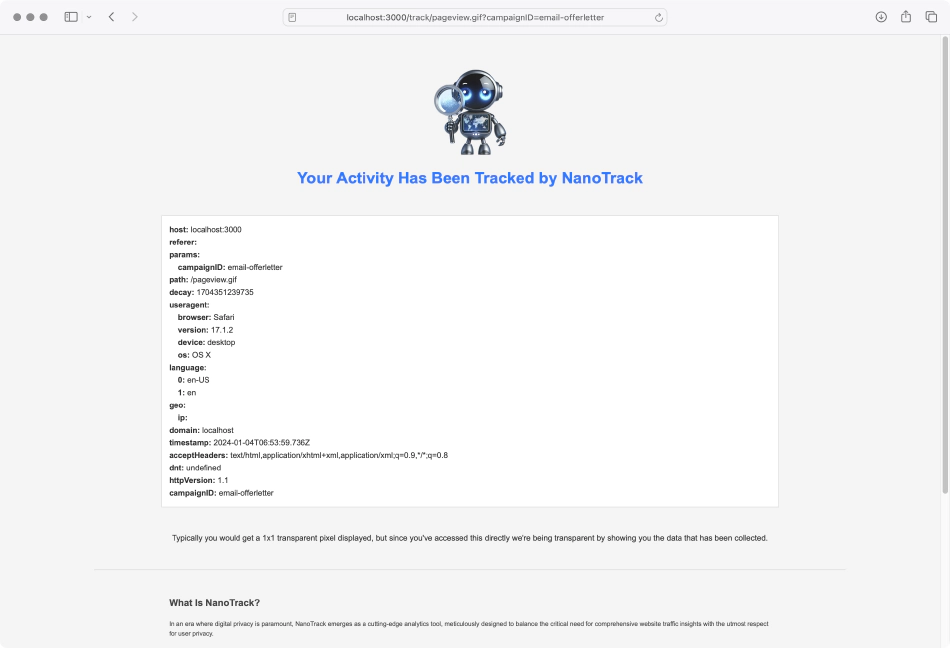Development - The Inside Scoop on Pixel Tracking and the Birth of NanoTrack
In the ever-evolving digital landscape, the unveiling of invisible technologies like pixel tracking has sparked conversations about privacy, ethics, and the invisible threads connecting our online interactions. Each click, every opened email, and every page browsed, weaves into a rich mosaic of data exchange. As we embark on this exploration, the creation of NanoTrack emerges as a pivotal moment in rethinking how we navigate the complex web of digital analytics.
The Hidden Narrators of Our Online Story - Pixel Trackers
Embedded in the vast world of the web, pixel trackers are silent yet pivotal players in documenting our digital interactions. Also known as web beacons, pixel tags, spy pixels, or transparent GIFs among other names, harnesses the simple act of image loading to relay information back to servers, revealing who, what, when, and sometimes where the image was loaded. These tiny, almost invisible 1x1 pixel images are integrated seamlessly into web pages and emails. Each time a pixel is loaded, it unlocks a trove of data, transforming a simple act into a rich narrative of user behavior and preferences.
The Anatomy of a Pixel Request
-
Initiating the Data Exchange: The journey begins when you access content containing a pixel tracker. This act prompts your browser or email client to request the pixel’s download from a server. While this might seem like a trivial action, it’s laden with significant information. The server captures this data, creating a detailed profile based on just this single interaction.
-
The Digital Beacon - IP Address: Your IP address stands at the forefront of this data exchange. More than just a series of numbers, it functions as a digital locator, hinting at your geographic location. When enhanced with geomatching tools like MaxMind, it can even pinpoint your city or neighborhood, offering insights into user demographics and location-based behaviors.
-
HTTP Headers - The Information Vessels: These headers are the couriers of additional data in every request. The User-Agent header provides insights into your browsing environment, including your browser type and operating system. The Referer header traces your digital path, revealing the webpage you visited before the current one. Together, these headers contribute to a nuanced understanding of user interaction patterns.
Navigating Privacy and Ethics in Pixel Tracking
The use of pixel tracking has raised ethical questions, particularly regarding privacy. The ability to track not just if an email was opened but also where it was opened introduces a level of surveillance that many users are unaware of, often conducted without explicit consent. This practice highlights the delicate balance between gaining insights and respecting user privacy.
While pixel tracking is indispensable in digital analytics, it raises significant questions about privacy and user consent. This process, ingrained in web communication, inherently collects detailed user data with every server interaction. It’s important to recognize that such data collection is not unique to pixel tracking but is a fundamental aspect of all server requests.
Understanding the inevitability of this data exchange is key. Despite privacy tools and measures, certain data like IP addresses and HTTP headers are always transmitted. These are essential components of how the internet functions and cannot be entirely blocked or hidden.

The ethical quandary lies not in the act of data transmission but in its usage and protection. In today’s digital age, where user awareness of privacy rights is increasing, there is a growing call for transparent and responsible handling of personal information. Ethical pixel tracking hinges on informed consent and the conscientious use of collected data, ensuring a balance between insightful analytics and the preservation of user privacy.
As the digital landscape continues to evolve, the exchange of data integral to web technologies will persist. The challenge and responsibility lie in managing this data ethically, respecting user privacy while harnessing the valuable insights it offers.
The Weight of the Web - A Tale of Efficiency Lost
Over the years, the internet has evolved into a richer, more interactive medium. However, this progress has brought with it an unintended consequence: an increase in the ‘weight’ of web pages. Websites burdened with complex JavaScript and extensive coding began to demand more from our devices and patience. This bloating of web pages has sparked a conversation about the role of JavaScript, particularly in analytics, and its impact on web efficiency and user experience.
The Double-Edged Sword of JavaScript
JavaScript is essential for adding interactivity to websites, but its heavy use, particularly for analytics, can slow down web pages and burden device resources. Moreover, JavaScript isn’t universally supported or enabled across all devices and browsers. For example, users on non-traditional web devices like smart fridges or car infotainment systems, or those who disable JavaScript for privacy or speed, aren’t captured by traditional JavaScript-based analytics.
This limitation highlights the need for a more versatile tracking method. Enter remote image embedding, used in pixel tracking, which doesn’t rely on JavaScript and works in almost any environment that can display HTML content. This approach ensures broader data collection, including from devices where JavaScript is unsupported or disabled, and also from various other digital communications like emails, offering a fuller picture of user engagement across the digital spectrum.
The Emergence of the “No-JS” Movement
In response to this growing web heaviness, a movement began to take shape. The “no-js” movement, driven by a community of developers and tech enthusiasts, advocates for a streamlined, efficient internet. It champions the philosophy of reducing reliance on JavaScript, especially for functionalities like analytics that don’t necessarily benefit the end-user. This approach, far from rejecting modern web capabilities, focuses on optimizing them to create a web experience that is faster, more accessible, and less resource-intensive.
NanoTrack – Changing Analytics with Simplicity and Ethics
In the dynamic world of web analytics, the inception of NanoTrack stands as a watershed moment. Responding to the growing concerns around pixel tracking, NanoTrack was developed as an innovative solution that respects user privacy while still providing valuable analytics. By redefining the approach to data collection and user tracking, NanoTrack aims to set new standards in the digital analytics realm. Born out of a digital ecosystem thirsting for change, NanoTrack was conceptualized and brought to life in a mere three days of intensive development. This tool transcends its functional role, embodying a revolutionary approach that harmonizes efficiency, privacy, and user experience, and reshapes the narrative of digital analytics.





The Foundational Pillars of NanoTrack:
Privacy-First Design
NanoTrack’s foundation is built on a strong commitment to privacy, reflecting this in features like optional IP anonymization to protect user anonymity. While NanoTrack is inspired by the principles of the General Data Protection Regulation (GDPR), it focuses on collecting non-personal data such as general device information, IP addresses (with an option for anonymization), and referring URLs, sidestepping the need for explicit consent typically required for personal data collection.
Additionally, NanoTrack honors the DoNotTrack (DNT) settings in browsers. If a user activates DNT, NanoTrack automatically stops all tracking for that individual, showcasing our respect for user privacy preferences and our commitment to ethical data practices. This approach ensures NanoTrack offers valuable insights while navigating the complexities of digital privacy with ease.
Minimalist Yet Powerful Data Collection
NanoTrack adopts a minimalist approach to data collection, meticulously focusing on essential information that allows developers and site owners to grasp how their content is interacted with, without delving into personal user identification or categorization. This method ensures the capture of general usage data—such as page views and interaction patterns—facilitating an understanding of engagement trends while consciously avoiding the collection of data that could be exploited by data brokers or used in targeted marketing.
By steering clear of tracking user sessions and sensitive identifiers, NanoTrack prioritizes user privacy, enabling insights into digital behaviors without the ethical quandaries or privacy concerns linked with invasive data practices. This streamlined, privacy-first strategy underscores NanoTrack’s dedication to providing valuable analytics in a manner that respects user discretion and security.
Effortless Integration
The hallmark of NanoTrack’s design philosophy is its unparalleled ease of integration, distinguishing it from the often complex and time-consuming setup processes associated with traditional web analytics platforms. The essence of implementing NanoTrack lies in its simplicity: a mere inclusion of an tag within the HTML of a website or an email. This tag, when pointed to the NanoTrack server, activates the analytics tracking without the need for any additional configurations or intricate setups for each new campaign or digital property.
This streamlined process eradicates common barriers to entry for web analytics, making NanoTrack an accessible solution for a wide range of users—from solo web developers and small business owners to digital marketers and content creators. By eliminating the need for specialized technical knowledge or extensive setup time, NanoTrack opens the door for more websites and online platforms to leverage advanced analytics insights effectively.
Moreover, the simplicity of NanoTrack’s integration facilitates rapid deployment across multiple pages and platforms, ensuring consistent data collection and analytics insights across an entire digital ecosystem with minimal effort. This ease of use does not only democratize access to sophisticated web analytics but also empowers users to focus more on leveraging insights and less on managing the tools themselves. The result is a more efficient, data-informed approach to digital strategy and user experience optimization, accessible to all levels of technical proficiency.
Redefining Efficiency
NanoTrack stands at the forefront of a new era in web analytics, presenting a revolutionary approach that significantly diverges from the traditional, heavier analytics frameworks exemplified by platforms like Google Analytics 4. Where Google’s latest analytics iteration demands a considerable 134kb for its loading process, NanoTrack’s embed code is astonishingly lean, requiring merely 860 bytes. This represents a reduction to less than 1% of the size required by Google Analytics 4, a fact that underscores NanoTrack’s commitment to efficiency and its alignment with the “no-js” philosophy.
By adopting a server-side strategy, NanoTrack eliminates the need for bulky scripts, showcasing that high-quality, actionable analytics can be achieved without compromising on website load times or user experience. This not only dramatically enhances site performance—crucial for retaining user engagement and satisfaction—but also positively influences SEO rankings, as search engines increasingly favor faster-loading sites. Despite its minimal footprint, NanoTrack doesn’t skimp on delivering insightful analytics, proving that efficiency and depth of insight can coexist. In doing so, NanoTrack redefines the standards for web analytics, offering a model that is over 99% more size-efficient compared to conventional solutions, thereby enabling websites to achieve a seamless blend of comprehensive analytics and optimized performance.
Open Source and Community-Driven Development
At the heart of NanoTrack’s philosophy lies its open-source, community-driven approach, a testament to the belief in collaborative innovation and the power of collective input. This framework not only makes NanoTrack freely available to all but also positions it as a self-hosted solution, giving users full ownership and control over their data and the analytics pipelines. By choosing NanoTrack, users aren’t just adopting an analytics tool; they’re embracing a platform where they command the data, free from external dependencies and the constraints often imposed by proprietary solutions.
The open-source nature of NanoTrack encourages a vibrant community of developers, data scientists, and web enthusiasts to actively engage in its development process. This inclusive environment welcomes contributions ranging from code enhancements to feature suggestions, ensuring that the tool remains responsive to the evolving needs of the digital landscape. Such a model thrives on transparency, with every aspect of NanoTrack’s development open for review, critique, and improvement by the community.
This self-hosted and community-fueled approach not only ensures that NanoTrack is continually refined and expanded upon but also reinforces the tool’s commitment to privacy and data sovereignty. Users can rest assured that their data remains theirs, securely housed within their own hosting environments, and used solely to advance their understanding of user interactions. By intertwining open-source accessibility with the autonomy of self-hosting, NanoTrack sets itself apart as a pioneering analytics solution, designed to empower users with actionable insights while upholding the principles of data ownership and community collaboration.
Educating and Advocating for Privacy
In its mission to harmonize advanced digital tracking with staunch privacy protections, NanoTrack doesn’t just stop at implementing privacy-forward features. It actively seeks to educate both users and visitors on the nuances of digital analytics and privacy considerations. This commitment to transparency and education is vividly demonstrated when users access the tracking pixel URL directly. Instead of a simple error or blank page, visitors are presented with a comprehensive tracking transparency page. This page doesn’t only introduce the visitor to what NanoTrack is and its foundational principles of privacy and minimal data collection but also goes a step further by showing users exactly what data has been collected.
This proactive approach serves multiple purposes: it demystifies the process of web tracking for the everyday user, reinforcing NanoTrack’s commitment to openness; it educates visitors on the importance of privacy in the digital realm; and it offers an unparalleled level of transparency by allowing users to see the extent of data collected. This could include generalized device information, IP addresses (which can be anonymized), and referring URLs, among other non-personally identifiable information.
By providing this level of insight and control, NanoTrack not only advocates for a future where digital analytics and privacy protections coexist harmoniously but also sets a new standard for how analytics platforms can engage with and inform their user base. This initiative aligns with NanoTrack’s broader vision of establishing an informed digital community where ethical tracking practices are the norm, and user privacy is paramount. Through these efforts, NanoTrack is not just a tool for gathering analytics but a platform for promoting a deeper understanding and appreciation of privacy in the digital age.
NanoTrack’s Beta Phase – Navigating New Frontiers
In its early-release beta phase, NanoTrack is much more than a static tool; it’s an evolving ecosystem. This phase represents a journey of adaptation and refinement, driven by user feedback and real-world applications. It’s a period of active development, where NanoTrack is not just fine-tuned but also re-envisioned to meet the diverse and changing needs of its user base.
I like to think that NanoTrack stands as a trailblazer in the realm of web analytics, heralding a new era where data collection is balanced with user privacy and ease of use. Its emergence marks a pivotal shift in the analytics landscape, championing a future where web analytics are not only intelligent and insightful but also inherently ethical and user-centric.
Getting Started with NanoTrack – A Quick Guide to Implementation
As NanoTrack reshapes the landscape of web analytics, its ease of deployment and use is a testament to its user-centric design. For those eager to harness the power of NanoTrack, the journey begins with a straightforward setup process, facilitated by the included Docker-compose file. This chapter provides a quick guide to getting NanoTrack up and running, making sophisticated web analytics accessible to everyone.
Step-by-Step Guide to Launching NanoTrack
- Step 1: Download NanoTrack: Start by downloading NanoTrack from DockerHub or directly from it’s GitHub repository . The package includes all the necessary files, including the Docker-compose file, which simplifies the deployment process.
](/blog/nanotrack/dockerhub.jpg)
-
Step 2: Setting Up the Environment: Before running NanoTrack, make sure Docker is installed and running on your machine. Then, navigate to the directory containing your Docker-compose file. This file defines the NanoTrack service and any other services it depends on, such as a database.
-
Step 3: Running NanoTrack: To launch NanoTrack, simply run the command
docker-compose upin the terminal. This command will start all the services defined in your Docker-compose file. Docker will download any necessary images, create containers, and start the services. Once the process is complete, NanoTrack will be up and running. -
Step 4: Implementing NanoTrack on Your Site: To start tracking with NanoTrack, you need to embed a simple
<img>tag in your website or email, pointing to your NanoTrack server. This tag will load the NanoTrack pixel, allowing you to start gathering analytics data. There’s no need for additional configuration or setup for each campaign or site. -
Step 5: Accessing Analytics Data: Once NanoTrack is operational, you can access your analytics data through the NanoTrack dashboard. This intuitive interface allows you to view and analyze the data collected by NanoTrack, offering insights into user behavior and web traffic patterns.
It’s That Easy
Setting up and running NanoTrack is a simple and straightforward process, thanks to its Docker-compose deployment and minimal configuration requirements. This ease of implementation makes sophisticated web analytics accessible to a wide range of users, from tech-savvy webmasters to those with limited technical background. With NanoTrack, harnessing the power of efficient and ethical web analytics is just a few steps away.
Charting a New Course in Web Analytics
NanoTrack, even in its early stages, is a symbol of a shift in the digital narrative. It challenges the established norms of web analytics, advocating for a more responsible, considerate, and user-centric approach to data collection. As we continue to navigate the ever-changing landscape of the internet, I hope that NanoTrack can stand as a beacon of innovation, guiding us towards a future where analytics are not only insightful but also ethical and respectful of the web’s greatest asset: its users.
In embracing tools and practices that prioritize user privacy, we take significant steps toward not only enhancing the digital experience but also protecting the fundamental rights of users across the digital universe.
Share This Post
When I first slid on the Apple Vision Pro, I was bracing myself for another overhyped gadget. Instead, what I encountered was a transformative leap into the future of digital interaction. This wasn’t merely a high-tech toy; it was a tool that seamlessly wove itself into my daily coding rituals, shattering my preconceived limits of what technology could achieve. From that moment, I was hooked—immersed in a mixed reality that felt both groundbreaking and surprisingly intuitive.
Etsuko Cowart - www.ihaveto.be
Katrin Billingsley - mnogovdom.ru
Allan Duffy - www.fcc.gov